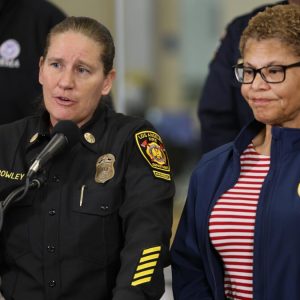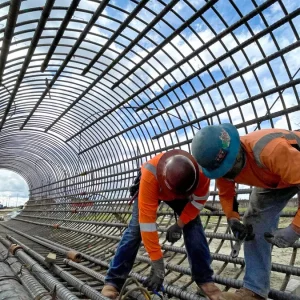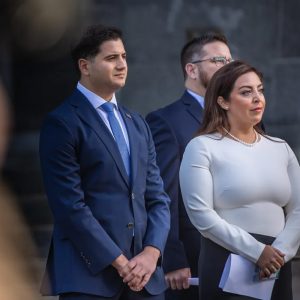Google defines citizenship as “the position or status of being a citizen of a particular country.” However, being a citizen entails so much more. A citizen isn’t labeled as an alien on legal documents, isn’t considered a public charge for seeking basic human services, is represented within the electoral system, has a nine-digit number that allows them to work legally and obtain federal school grants, and can see their family members that live outside of the country. Being a citizen means you belong and are recognized by the United States as human. On the other side, noncitizens or undocumented immigrants cannot enjoy the privileges of being recognized as citizens even though many have lived in the U.S. for most of their lives, pay taxes, and contribute to the country’s wellbeing.
The relentless advocacy of the undocumented community, particularly through immigration nonprofits, has been to establish a permanent pathway to citizenship. To understand ongoing debates, it’s crucial to recognize the existing legislation that has enabled undocumented immigrants to secure legal residency and, subsequently, citizenship in the United States.
The Registry Act of 1929 allowed undocumented immigrants to apply for residency as long as they arrived before the “cutoff date” of 1921, were “well behaved,” and had no deportable history. The Registry Act of 1929 cutoff date has been updated multiple times, with the last being The Immigration Reform and Control Act, also known as Amnesty, under Ronald Reagan’s presidency. Reagan’s 1986 Act updated the cutoff date to 1972, so “this program is only available to eligible non-U.S. nationals (aliens under federal law) who entered the United States before January 1, 1972”. However, Reagan’s update to the registry was the last major pathway to citizenship. Immigrant advocates are steadfast in pursuing a permanent pathway to citizenship by updating the cutoff date to a rolling registration date.
Registry is not something new or unprecedented. The cutoff date for the registry has just not been updated in the past 37 years, and immigrant advocates are fighting to update the registry to a more current date. The Department of Homeland Security’s Yearbook of Immigration Statistics (FY 1996-2021) shows that between 1989 and 1989, 58,914 immigrants obtained a green card through the registry. However, in 2020, only 101 immigrants benefited from the registry. Hence, the cutoff date of 1972 is outdated and needs to be updated again.
In 2023, Senator Alex Padilla introduced S.2606, the Renewing Immigration Provisions of the Immigration Act 1929. This bill “removes this entry cutoff date [1972] and opens up the program to eligible individuals who have resided in the United States for at least seven years.” However, an update to the cutoff date is not the only demand. Because several updates have been made to the Registry before, immigrant advocates are pushing for a “rolling” registry, where the cutoff date is continuously updated to cover recent immigrants. Hence, this bill automatically covers immigrants who have arrived in the United States in the last seven years without Congress having to pass new legislation. This bill would need approval from the House and the Senate to pass. While S.2606 is merely an update to existing law, it will face a hard pass in the federal legislature. Nonetheless, the fight for this bill is worth it to create lasting protections for immigrants.
S.2606 can potentially transform the lives of millions of immigrants, and its introduction can’t be credited to just one Senator. For almost a decade, immigration advocates across the country have been organizing political support for an expansion to the Registry. At the bustling intersection of W 3rd St. and Carondelet St. in Los Angeles, a beacon of hope for immigrants shines: the Coalition of Humane Immigrant Rights, or CHIRLA. This immigration nonprofit, with a history spanning over three decades, is home to a vibrant network of policy and community advocates united in their mission to pave a pathway to citizenship. Founded in 1986 with the vision of a just society that embraces immigrants, CHIRLA has secured significant immigration victories, such as the Dream Resource Center Grant Program. However, the battle is far from won. Just two years ago, CHIRLA launched their “All in Our Fight for Citizenship” campaign, a testament to their unwavering commitment to updating the Registry and advocating for a permanent pathway to citizenship.
José-Arnulfo Cabrera, Deputy Director of National Policy and Campaign at CHIRLA, spoke with me to provide insight into what this rolling registry date bill would look like. Born in Oaxaca, Mexico, Cabrera immigrated to the United States with his mother when he was four. He grew up undocumented and later applied for DACA. His U-Visa application was recently approved after ten years, enabling him to apply for citizenship. Cabrera was exposed to community organizing at a young age since his mother was an organizer in Cincinnati, Ohio, working with undocumented workers. He shared that he first shared his story while organizing around the California Dream Act in 2009.
Throughout his life as an organizer, he shares that he “always fought for something that would create a pathway to citizenship, and it was always for undocumented youth.” Spending countless hours on Capitol Hill, he became an expert on how immigration bills work. He states, “So much of the negotiation happening in Capitol Hill was ‘we will give you a pathway to citizenship for undocumented youth in exchange for more ICE and border enforcement.’” He believed this compromise was equivalent to obtaining a pathway to citizenship for himself in exchange for deporting his mother.
Through budget reconciliation, in which the House and Senate tried to rewrite how the U.S. budget is structured, immigrant advocates devised ways to construct a viable pathway to citizenship. Through this process, Cabrera first heard about Registry in 2021 when the Democrats controlled the House and Senate.
Cabrera told me, “I remember listening to what registry was, and I got pissed. I was pissed. So you mean to tell me that for this whole time, we’ve had a clear pathway to citizenship that had been happening since the Reagan administration, and just now, you’re telling us this? It was like they kept the best-kept secret until now. The cleanest, most simple, most direct way [for citizenship].”
What makes the Registry the best answer to a pathway to citizenship? Cabrera explained that other immigration legislation, such as the Dream Act, the Promise Act, DACA, and the Dignity Act, have all had exclusions. For example, DACA only allowed certain youth immigrants to apply for the temporary protection program if they had resided in the U.S. since 2016, and the Promise Act was only for TPS (Temporary Protected Status) holders. Additionally, these do not always lead to a pathway to citizenship; instead, they provide temporary protection that will expire and put millions of lives in limbo.
In contrast, Cabrera shares that “with Registry, it doesn’t matter whether you have DACA, TPS; if you’re undocumented, you will get a pathway to citizenship. It’s also keeping the idea of families united and together because I feel like with all these other [bills and policies], it gives one specific group a pathway to citizenship, and I don’t think it’s fair.” Furthermore, he believes that passage of a rolling Registry bill means “recognizing [our] humanity, recognizing us as individuals, and honoring the work and roots we have built into this country and our neighborhoods.”
Though the Registry is existing legislation, and updates have been made before, the Federal government has been stalled for 37 years in implementing an updated pathway to citizenship. “It’s a tough bill to pass, but … [it has been] since 2016 that we talked about creating a pathway to citizenship not just for me but for my mom and my uncles [that] really recognizes the humanity and dignity that our community deserves,” states Cabrera.
If the Registry has been updated in the past, it can surely be updated again and become a rolling registry. The only thing that needs to be done is for the immigrant community to unite and advocate for a bill that will include all, not exclude some. When I first heard of this bill as an immigrant, I did not think it was possible because most policies only grant partial and temporary permission. However, this bill is possible, and just as Cabrera puts it, the immigrant community needs to “fight for what we deserve, not trying just to get what we can get. I know that’s hard, very visionary, but I’d rather die on that hill than anything else.” Until the Registry bill passes, the steps of Capitol Hill will be flooded with the bodies and voices of millions of undocumented immigrants yearning for inclusion.
Featured Image Source: CHIRLA





Comments are closed.